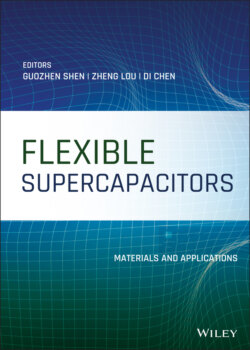Читать книгу Flexible Supercapacitors - Группа авторов - Страница 11
1.1 Introduction
ОглавлениеRecently, flexible electronic products, such as flexible microphones [1], elastic circuits [2–4], pressure and strain sensors [5–7], artificial skin sensors [8–10], intelligent garments [11], and wearable health monitoring devices have boomed as a new and important field of modern electronics (Figure 1.1). Therefore, the development of suitable energy storage devices, which can serve as an excellent power supply while sustaining high mechanical flexibility, are becoming increasingly necessary to power these electronics [13–21]. Supercapacitors (SCs), also known as electrochemical capacitors or ultracapacitors, have emerged as the bridge between batteries and traditional capacitors due to their promising merits of high power density (about 10 kW kg−1), good reversibility, excellent cyclic stability (over 106 cycles), and safety [22, 23]. Meanwhile, accompanied with the advanced development of lightweight, foldable, and stretchable materials, substantial effort has been invested in the fabrication of flexible supercapacitors (FSCs) [24–28].
In order to satisfy the further demand for practical usage, the configuration of the two electrodes as well as the geometry of the devices are of vital importance and worth careful considerations [29]. The major obstacle of early designed FSCs is their relatively low energy density (E) to mismatch basic requirements of future applications. Thus, tremendous efforts have been denoted to optimize the overall performance of FSCs according to the Eq. (1.1), without sacrificing their power density and service life.
In general, either enhanced capacitance (C) or enlarged operating voltage (V) of the device should make sense. Of which, the C of a FSC device can be equivalent to the negative electrode capacitance (C n) and positive electrode capacitance (C p) connected in series (Figure 1.2a), which can be calculated using Eq. (1.2)
Figure 1.1 (a, b) Scheme and optical image of a flexible acoustic device.
Source: Reproduced with permission from Ref. [121], © 2017, Springer Nature.
Optical image of (c) a flexible circuit
Source: Reproduced with permission from Ref. [2], © 2018, NPG
, (d) multiplexed fingerprint sensor. Scale bar, 1 cm.
Source: Reproduced with permission from Ref. [5], © 2018, NPG
and (e) artificial skin electronics
Source: Reproduced with permission from Ref. [8], © 2018, NPG.
(f) 3 × 3 honeycomb‐like supercapacitor array powering LED panel.
Source: Reproduced with permission from Ref. [13], © 2017, Wiley.
(g) Image of an array of field‐effect heterojunctions on textile.
Source: Reproduced with permission from Ref. [14], © 2017, NPG.
(h, i) Fabrication and optical image of the fiber‐shaped Al‐air battery.
Source: Reproduced with permission from Ref. [15], © 2016, Wiley.
Figure 1.2 (a) The equivalent circuit of an AFSC. (b) Schematic illustration of the typical configuration of AFSCs and (c) Cyclic voltammograms (CV) curves as schematic illustrations of typical AFSCs.
Source: Reproduced with permission [30]. © 2016, Royal Society of Chemistry.
The maximum C value of the FSCs can be reached when C n is equal to C p . Thus, early investigations focused on the symmetric flexible supercapacitors (SFSCs) with cathodes and anodes being identical for achieving higher device capacitance [31–34]. However, due to their limited potential voltage (<1 V in aqueous electrolyte), the energy density of SFSCs is still unsatisfactory. Notably, the V of a FSC device related to the capacitive potential range of electrodes. Thus, asymmetric flexible supercapacitors (AFSCs), also called hybrid SCs or battery‐capacitor SCs, are designed with different electrodes configured together (Figure 1.2b) [24–28]. By making use of the distinct capacitive potential range, AFSCs have been widely proven to effectively achieve high operating voltages (even >2 V in aqueous electrolyte) as well as optimized capacitance after balancing the charge between the specific positive and negative electrodes (Figure 1.2c) [30, 35]. In addition, they have several important advantages including small size, low weight, ease of handling, excellent reliability, and a wider range of operating temperatures. Therefore, AFSCs have become one of the most promising energy storage devices for flexible and wearable electronics.
In this context, to achieve high electrochemical performance while maintaining good mechanical stability, FSCs with asymmetric structure could realize further gains, and thus arouse global efforts in relative research. This chapter enumerates some typical newly developed AFSCs in terms of structure design of electrode materials and device's configuration engineering. We first focus on the guidelines on the material design and charge balance of a typical AFSC device. Furthermore, different types of various newly developed AFSCs, including sandwich‐type, fiber‐type, and the other type of AFSCs devices, are illustrated based on various electrode materials. Finally, the future developing trends and challenges are discussed to provide certain reference to readers on how to contrive this device.
